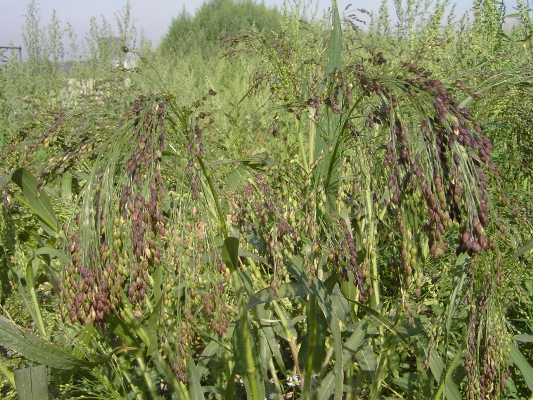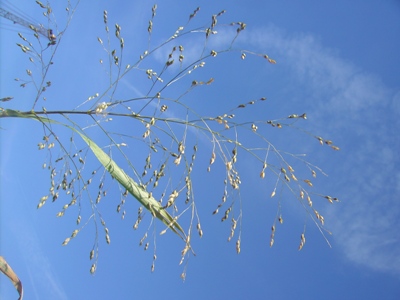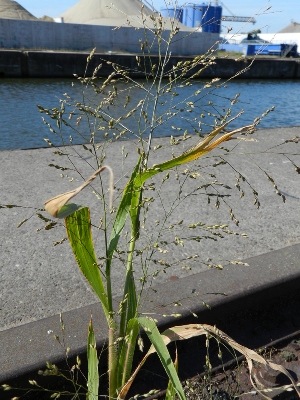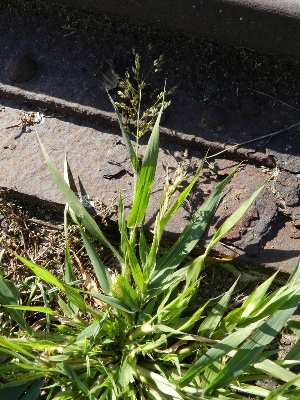6. Panicum miliaceum L. (C-As.) – A common but often ephemeral alien, usually introduced as a commercial birdseed component (millet) and much spilled by roadsides, railway tracks, in cities and port areas, near grain mills, under conveyors or on dumps. Panicum miliaceum is known at least since 1868 and by far the commonest representative of the genus in Belgium.
Panicum miliaceum is a rather variable species and several infraspecific taxa have been described (see key below). The usual alien surely is subsp. miliaceum, the crop plant with a dense, conspicuously drooping inflorescence. It lacks the ability for self-sowing and therefore remains strictly casual. In recent years two additional, weedy mutants have been observed in Belgium. Subspecies ruderale (Kitagawa) Tsvelev is confined to port areas so far and doubtlessly introduced with cereals, probably of Central-European or American origin (where it is an exceedingly noxious agricultural weed, especially in corn fields; see for instance Freckmann & Lelong 2003). In Belgium known since 1996 and, though seen most years, it seems to remain ephemeral. A third taxon, subspecies agricola H. Scholz et Mikoláš, is a recent newcomer and an obligate weed of maize fields in Belgium. It is known so far from rather few localities and was recorded for the first time in the surroundings of Bree in 2002. It probably is naturalised locally but hardly seems to spread so far.
The three subspecies are distinguished as follows:
1 Spikelets not caducous (not disarticulating below the glumes) and remaining on the panicle branches, even at maturity. Mature fertile florets not falling off. Panicle soon drooping under the weight of the fertile florets === subsp. miliaceum
1 Spikelets caducous or not. Mature fertile florets easily falling off. Panicle more or less erect or only slightly drooping, often rather diffuse === 2
2 Spikelets caducous, disarticulating below the glumes === subsp. ruderale
2 Spikelets not caducous, glumes remaining on the panicle branches after fertile florets have fallen === subsp. agricola
The distinction between these taxa is most of the time clear-cut but intermediate plants sometimes occur and subspecific boundaries might get further blurred in the future.\
Herbarium specimen of subsp. miliceum
Herbarium specimen of subsp. ruderale
Herbarium specimen of subsp. agricolum
|
Panicum miliaceum subsp. miliaceum |
Panicum miliaceum subsp. ruderale |
|
Panicum miliaceum subsp. ruderale |
Panicum miliaceum subsp. ruderale |

|
subsp. agricola |
subsp. ruderale |
subsp. miliaceum |
Selected literature:
Bough M., Colosi J.C. & Cavers P.B. (1986) The major weedy biotypes of proso millet (Panicum miliaceum) in Canada. Canad. J. Bot. 64(6): 1188-1198.
Freckmann R.W. & Lelong M.G. (2003) Panicum. In: Barkworth M.E. & al. (eds.), Flora of North America north of Mexico, vol. 25: 450-488. Oxford University Press, New York-Oxford.
Hügin G. (2010) Panicum dichotomiflorum, P. hillmanii, (P. laevifolium), P. miliaceum subsp. agricola, P. miliaceum subsp. ruderale und Setaria faberi in Südwestdeutschland und angrenzenden Gebieten. Ber. Bot. Arbeitsgemeinschaft Südwestdeutschl. 6: 31-68.
Lippert W. (1984) Beiträge zu kritischen oder wenig beachteten Arten und Artengruppen der bayerischen Flora. Ber. Bayer. Bot. Ges. 55: 63-65.
Robbrecht E. (1983) Autosnelwegneofieten, een kategorie van graanadventieven in opkomst? Dumortiera 26: 6-13.
Scholz H. (1983) Die Unkraut-Hirse (Panicum miliaceum subsp. ruderale) – neue Tatsache und Befunde. Pl. Syst. Evol. 143: 233-244.
Scholz H. & Mikoláš V. (1991) The weedy representatives of Proso Millet (Panicum miliaceum, Poaceae) in Central Europe. Thaiszia 1: 31-41.








